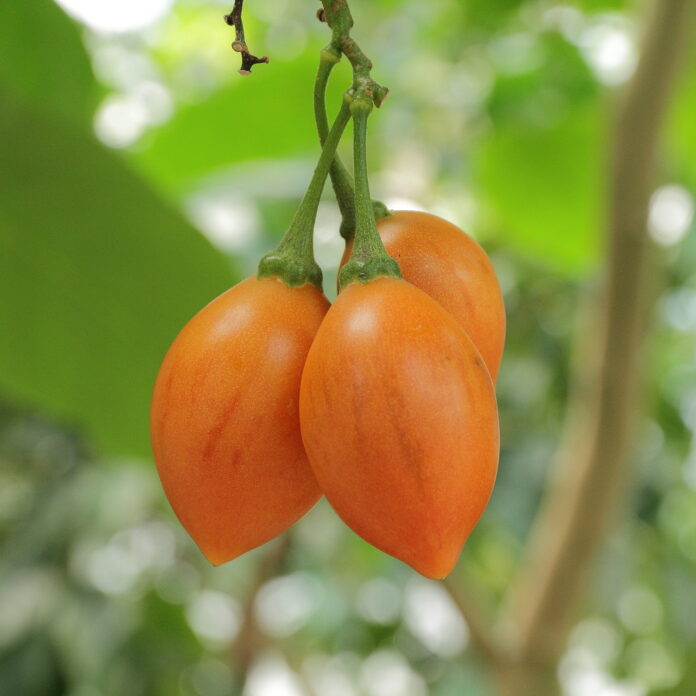Tamarillo, often referred to as the “tree tomato,” is an egg-shaped fruit that comes from the Solanaceae family, which also includes tomatoes, potatoes, and eggplants. The scientific name of the tamarillo is Solanum betaceum. Native to the Andean regions of Ecuador, Colombia, Peru, and Bolivia, tamarillo is now widely cultivated in other parts of the world, including New Zealand, which is one of the top producers.
Interesting Facts About Tamarillo:
- Origin: Tamarillo is native to the Andes region of South America, specifically in countries like Peru, Ecuador, Bolivia, Chile, and Argentina. It was first domesticated in this region over a thousand years ago and is also referred to as the “tree tomato” due to its resemblance to tomatoes
- Global Cultivation: While originally from South America, tamarillo is now grown in countries around the world, including New Zealand, Australia, India, the United States, and parts of Africa. New Zealand is particularly known for its tamarillo production
- Named in New Zealand: The name “tamarillo” was coined in New Zealand in 1967 by the Tree Tomato Promotions Council. Prior to this, the fruit was simply called “tree tomato,” which was deemed too similar to regular tomatoes. The name “tamarillo” was created to make the fruit sound more exotic
- Three Varieties: There are three main types of tamarillo: red, gold, and amber. The red variety is more tangy and often used in savory dishes, while amber tamarillos are the sweetest, making them ideal for desserts
- Belongs to the Nightshade Family: Tamarillo belongs to the Solanaceae family, which includes tomatoes, peppers, and eggplants. Despite this, it has a distinct flavor and appearance, differing from its tomato cousins
- Shape and Size: Tamarillos are oval-shaped and about the size of a large egg. They have smooth, thin skin and contain small, edible seeds that resemble those of tomatoes. The flesh can be smooth or slightly granular depending on ripeness
- Flavor Profile: The fruit has a unique flavor combination of sweetness, tartness, and slight bitterness. Red tamarillos have a tangy, savory profile, while amber ones are much sweeter, making them more suitable for desserts
- Low in Calories: Tamarillo is a low-calorie fruit, making it a great option for those looking to maintain a healthy diet. A typical tamarillo has only about 30 calories per 100 grams, making it a filling yet low-energy snack
- Diabetes-Friendly: With a low glycemic index and high fiber content, tamarillo is beneficial for people with diabetes as it helps regulate blood sugar levels and provides a steady release of energy
- Antimicrobial and Anti-inflammatory: Some studies suggest that tamarillo has antimicrobial and anti-inflammatory properties, making it useful for treating infections and reducing inflammation in the body
- Popular in New Zealand: New Zealand is a major producer of tamarillo and helped popularize the fruit in international markets. Tamarillos are grown in orchards across the country, and the fruit is considered a national specialty
- Tamarillo Juice: The fruit is often pressed into juice, which is tangy and refreshing. In some cultures, tamarillo juice is used in cocktails, smoothies, or simply as a refreshing drink on its own
- In Ecuador, tamarillo is used in traditional dishes like “locro de papas,” a potato soup, and is often paired with avocados and fresh cheese. In other parts of South America, it’s a popular ingredient in salsas and sauces
- Growing Conditions: Tamarillo trees thrive in subtropical to tropical climates and need warm temperatures, well-drained soil, and plenty of sunlight. They are often grown at altitudes of 1,000 to 3,000 meters above sea level
- Toxicity in Green Tamarillo: The green or unripe tamarillo fruit contains solanine, which is toxic if consumed in large quantities. While rare, some individuals have experienced food poisoning symptoms after ingesting unripe tamarillos. Solanine toxicity can cause nausea, vomiting, and digestive upset
